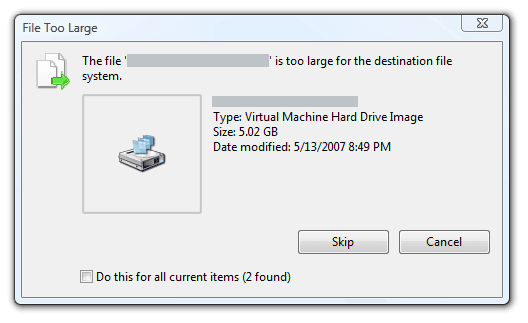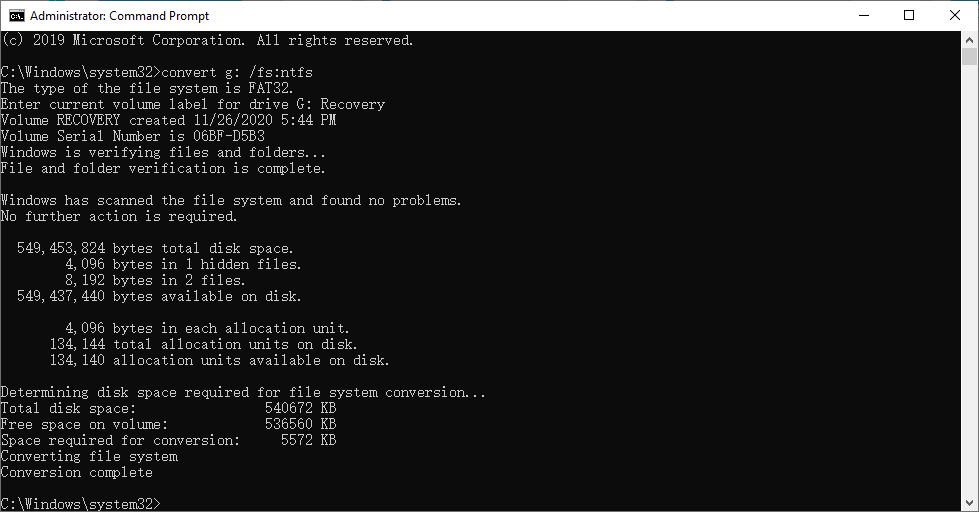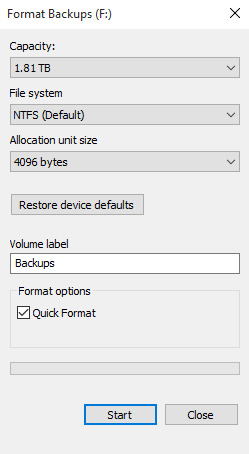Solved | File is too Large to Copy to External Hard Drive (4 Ways)
This article explores why this problem occurs, primarily due to file system limitations such as FAT32’s 4GB maximum file size cap. We’ll offer multiple solutions for resolving the issue, from converting your drive's format to NTFS or exFAT, using compression tools, and other workarounds.
Why can't I copy large files to an external hard drive?
“Bought a 250 GB USB WD external drive to back up my video footage. Some files are around 7 GB. When I try to copy one file to the external hard drive, I get the message: ‘The file is too large for the destination file system’. Does anyone know what that means and why I can’t copy a 7 GB file to a 250 GB hard drive?”
– Microsoft Community
For security or portability reasons, you may want to store important data on a removable device, but end up finding the file too large to copy to an external hard drive or USB, even when there's sufficient space in it. Why did this happen, and how to transfer large files to an external hard drive successfully?
Well, one possible reason is that the file is really larger than the available space on the external hard drive. But the most likely situation is as in this case - the file is too large for the destination file system.
It happens because each file system has its own size limitation. FAT (also known as FAT16) only supports a file up to 2 GB, FAT32 supports up to 4 GB, as for NTFS, the maximum file size is 16 TB. You can’t transfer a file that exceeds the limit of the destination drive even when it has plenty of spare space. Such being the case, you can take the following measures to fix the problem and copy large files smoothly.
Best free backup software to help you backup large files to external drive.
How to fix the problem that a file too large for an external hard drive
If you fail to copy large files to an external hard drive or USB, you should check the available space and file system of the destination drive at first, and then pick a solution according to your case.
Method 1. Check your external hard drive or USB
Anyway, first check that your device is connected properly and make sure it really has more available space than the file you want to copy. If not, you can take the most direct way – prepare another external hard drive or USB flash drive with sufficient space.
Method 2. Convert the file system to NTFS
If you encounter the "file too large for the destination file system" error, even though your external hard drive has plenty of space, it's likely because the drive is formatted as FAT or FAT32. These file systems have a file size limit of 2GB or 4GB, preventing you from transferring larger files. To fix this, you’ll need to convert the file system to NTFS, which doesn’t have these size restrictions.
★ Check the file system information: Open File Explorer, and right-click on the external hard drive. Select "Properties" and find the file system under the "General" tab.
★ Convert file system without losing data:
If the drive already contains important files, you can safely convert the file system to NTFS without losing your data.
1. Press Windows logo key + R at the same time. Type cmd in the box and click OK.
2. Type the command: convert n: /fs:ntfs (“n” refers to the drive letter of external hard drive).
3. Press Enter key to run it, and enter the volume label (name) if required. Within a few minutes, FAT32 formatted external hard drive will be converted to NTFS successfully. Then you can copy large files to it as normal.
Note: There are chances that you fail to convert file system to NTFS due to low disk space, non-standard cluster, non-continuous volume, etc. If so, you can go to Method 4.
★ Re-format the drive directly:
This solution can help you convert FAT/FAT32 to NTFS or vice versa, but it will erase all data on the drive. Therefore, you’d better backup the external hard drive before formatting.
1. Open File Explorer, right-click the drive, and choose Format...
2. Find the File system select box in the popping-out windows, and choose the option you want from the drop-down menu. Here choose NTFS.
3. Click Start and then OK to confirm the operation. Wait for a while, this external hard drive will be converted to NTFS successfully.
Tip: Alternatively, you can right-click the drive in Disk Management and Format it in a similar way.
Method 3. Re-connect the external hard drive or USB
If you find the file too large for the destination file system when the drive is already NTFS formatted, it’s probably because it's still identified as FAT/FAT32. Then you can try reconnecting the drive without physically unplugging it.
1. Right-click the Start button and choose Device Manager, or directly search for it.
2. Find the external hard drive or USB drive in the list, right-click it, and choose Disable device.
3. Wait for a while and then Enable it.
Tip: Alternatively, you can open Disk Management, right-click the drive, and choose Eject. To reconnect it, you need to change its status to Online.
Method 4. Backup a large file to an external hard drive directly
Besides the methods mentioned, you can also back up large files directly to an external hard drive using reliable software like AOMEI Backupper Standard. If your target drive is formatted as FAT32 or FAT, this tool automatically splits the backup file into 2GB or 4GB chunks, so you don’t need to convert the file system. Here are some key benefits:

-
Automatic backups for large files: schedule backups daily, weekly, or monthly, so you don’t have to worry about data loss from forgetting to back up.
-
Backup only modified files: With the incremental backup feature, it saves time and space by backing up only the files that have changed, rather than everything.
-
Reduce backup size: You can shrink the backup file size with compression or split large images into smaller files to optimize storage.
Download it to have a try if you use Windows 11/10/8/7/Vista. For server users, try the AOMEI Backupper Server.
You can effortlessly use the software for continuous data protection, and once there’s an image file too large to transfer to a USB or external hard drive, this software will take care of this automatically by splitting the image into 4GB or 2GB. Please follow the steps to copy large files to the FAT32 external hard drive without converting the file system.
Preparations: Install the software on your computer and connect the external hard drive properly.
1. Open AOMEI Backupper, go to the Backup tab and choose File Backup.
2. Click Select Source > Add Folder or Add File to locate the folders or files you want to backup to external hard drive.
3. Select the connected external hard drive as the destination.
4. Click Options > Advanced > Splitting to specify the size you want to split the image file into and click OK to confirm it. There are 3 options available:
- Automatic (split the backup image into 4GB or 2GB depending on the file system of the target disk)
- Custom size (the minimum file size is 50MB)
- Choose a predetermined size
5. Click Start Backup to backup large files to the external hard drive. After splitting, it’s recommended to keep these image files in the same directory to ensure the convenience of data management.
🌟Other useful features you may need:
- The Options feature allows for additional settings like reducing the file size with a higher compression level, enabling email notifications, adding comments, and more.
- To automate the process and manage large files efficiently, you can use Schedule for automatic backups. Schedules include One Time, Daily, Weekly, Monthly, and Event triggers, etc.
- By default, this software will create incremental backups after first full backup if you set a scheduled backup task. Incremental backup has a high requirement for recovery compared to differential backup. Click Incremental or Differential Backup to learn more differences.
- Long-term backups may result in the backup disk full issue, thus it's suggested to enable the Backup Scheme to delete old backups automatically. You have 4 options, By quantity, By time, By daily/weekly/monthly and By space. You need to upgrade before using it.
FAQs About "File Too Large to Copy to External Hard Drive"
Q 1: Why is FAT32 limited to 4GB for a single file?
A 1: FAT32, an older file system developed in the 90s, has a maximum file size limit of 4GB. This was sufficient for the time, but modern files—especially videos and backups—exceeded this limit. NTFS and exFAT were developed to overcome this limitation.
Q 2: What is the difference between NTFS and exFAT?
A 2: NTFS is the file system used by Windows for internal drives, offering advanced features like security permissions and compression. exFAT, on the other hand, is optimized for external drives, supporting large files without the overhead of NTFS, making it compatible with both Windows and macOS.
Q 3: What are the downsides of formatting an external drive to NTFS?
A 3: While NTFS allows for larger files, it’s primarily compatible with Windows. If you use the drive with a Mac, it will only have read capabilities unless third-party software is installed.
Expert Tips to Avoid File Transfer Issues
- Always check your drive’s file system before transferring large files to avoid compatibility issues.
- Compress files to save space and reduce transfer times when moving data to external drives.
- Use exFAT for cross-platform compatibility if you frequently switch between Windows and macOS.
Verdict
Don't panic when your file is too large to copy to the external hard drive. Take some time to try the above methods, or use AOMEI Backupper Standard to back up the large file to an external hard drive automatically. Considering external hard drives could be damaged or lost easily, you can use this freeware to backup files to cloud drives, network, or NAS devices as well.
In addition, if you want to copy a partition or a disk for hard drive replacement, the Clone feature also comes in handy. With the intelligent clone technology, you can even clone a larger drive to a smaller SSD.





